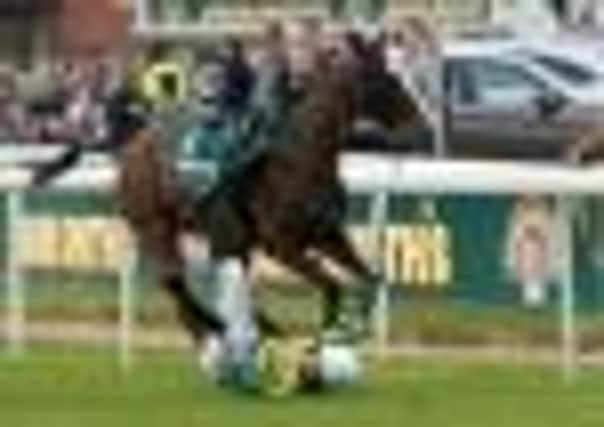Changes for ‘safer’ Grand National


Various amendments to the country’s most famous race were made in time for this year’s race, but the deaths of According To Pete and the Cheltenham Gold Cup winner Synchronised created further unpleasant headlines for the sport.
With the start now moved further away from the crowds and grandstands, the distance of the race will be around four miles and three-and-a-half furlongs, rather than four-and-a-half miles.
Advertisement
Hide AdAdvertisement
Hide AdOther changes include the ‘no-go’ zone being extended from 15 yards to around 30 yards from the starting tape, while the starter’s rostrum has been moved to a position between the tape and the ‘no-go’ zone to reduce the potential for horses to go through the starting tape prematurely.
There will be a specific briefing between the starters’ team and the jockeys on the day, part of a concerted BHA effort to improve starts in National Hunt races.
They are also looking at measures to reduce the possibility of a riderless horse travelling an extended distance before being caught prior to the National start.
Jamie Stier, director of raceday operations and regulation for the BHA, said: “Following this year’s race, our priorities were to establish the facts surrounding the incidents that occurred during the running of the race and, secondly, to review the events which led to what was an unsatisfactory start to the race.
Advertisement
Hide AdAdvertisement
Hide Ad“We have worked closely with Aintree and consulted widely with jockeys, trainers and legitimate welfare organisations – the RSPCA and World Horse Welfare – on a range of elements related to the race.
“Our objective in recommending changes to the start is to identify ways in which we can create a calmer and more controlled environment for both the horse and rider.
“It is possible that a more controlled environment at the start, along with reducing the distance between the start and the first fence, could have the effect of reducing the early speed of the race. If this were to be the case, it would be an added benefit.”
Aintree and the BHA are to embark on a three-year programme looking at alternative fence designs on the National course.
Advertisement
Hide AdAdvertisement
Hide AdThe so-called ‘core’ of the fences are currently made up of timber and protective rubber padding, but some will be trialled with a different core at the meeting in December. The fence heights will, however, remain unchanged.
Becher’s Brook has undergone further levelling of the wider landing zone – “correcting the settlement which occurred following works carried out in 2011” – but the fence itself remains the same.
Work has also been done on the landing areas of fences four, five and 13.
The field size is to remain at 40 runners, while £100,000 has been invested to help further improve the course’s watering capabilities.
Advertisement
Hide AdAdvertisement
Hide AdHowever, the RSPCA, while supportive of many of the changes, voiced several points of worry, and a statement read: “We remain concerned that two significant issues have not been addressed sufficiently by these changes. These are the impact of Becher’s Brook and the field size which remains the same.
“While the proposed improvement at Becher’s by the additional levelling of the adverse slope on the landing zone can only be beneficial, we believe that the remaining many complexities of this fence mean that it continues to pose a serious and unacceptable threat to horse welfare.
“We will watch carefully the impact of this change at Becher’s at the 2013 Grand National. This is the BHA’s last chance to show that this fence can pose a fair and safe challenge to horse and jockey.
“Given the number of fallers and failures to complete the course, we do not accept that the field should remain at 40. Clearly many horses compete at the Grand National that cannot complete it.
Advertisement
Hide AdAdvertisement
Hide Ad“We welcome the constructive dialogue that has taken place to date between us and believe that this is the best way to improve the welfare of racehorses.
“The testing nature of the Grand National will always produce a higher level of risk. That risk must be appropriate and the safety of horses paramount.
“Consequently the Grand National and related races will remain high on our agenda.
“We will seek permission for more RSPCA equine officers to be present at Aintree and will pay even closer attention to the conduct of the 2013 Grand National and its welfare outcome.”
Advertisement
Hide AdAdvertisement
Hide AdDonald McCain, who has trained a National winner and whose late father Ginger’s name was synonymous with the race, said: “I think Aintree have shown they are always trying to find new ways to make the race safer and better.
“They have looked into a couple of things to do with the start and I welcome that, as this year’s start wasn’t acceptable.”
Aintree moves to make race safer
Moving forward the start of the Grand National by 90 yards – taking it further away from the crowds and grandstands and reducing the distance of the race to around four miles and three-and-a-half furlongs.
Introduction of a ‘no-go’ zone being extended from 15 yards to around 30 yards from the starting tape.
Advertisement
Hide AdAdvertisement
Hide AdStarter’s rostrum has been moved to a position between the tape and the ‘no-go’ zone to reduce the potential for horses to go through the starting tape prematurely.
Plans are being finalised to introduce a specific briefing between the starters’ team and the jockeys on the day, part of a concerted BHA effort to improve starts in National Hunt races.
The BHA are also looking at measures to reduce the possibility of a riderless horse travelling an extended distance before being caught prior to the National starting.